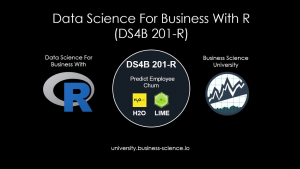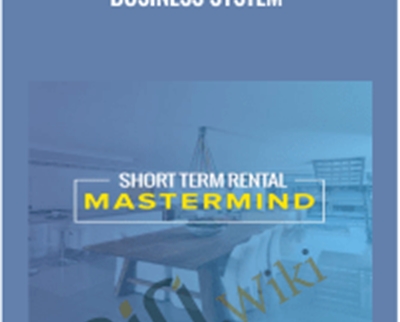Buy DS4B 201-R – Data Science For Business With R Course at GBesy. We actively participate in Groupbuys and are committed to sharing knowledge with a wider audience. Rest assured, the quality of our courses matches that of the original sale page. If you prefer, you can also buy directly from the sale page at the full price (the SALEPAGE link is directly provided in the post).
We join Groupbuy AND always try to share knowledge with more people. Especially the quality is the same as salepage. You can buy directly at salepage, with full price. (link SALEPAGE are mounted directly on the post)
DS4B 201-R – Data Science For Business With R

Please note that the Shiny Web Application is built in DS4B 301-R: Building A Shiny Web Application (Coming Soon!)
DS4B 201-R teaches you the tools and frameworks for ROI-driven data science using the R-programming language.
Over the course of 10-weeks you’ll dive in-depth into an Employee Attrition (Churn) problem, learning & applying a systematic process, cutting-edge tools, and R code.
At the end of the course, you’ll be able to confidently apply data science within a business.
The difference with the DS4B 201-R program: You get results!
About The Program
This short presentation overviews the DS4B 201-R program.
Who Is This Program For?
We have hundreds of data scientists in the course. Mainly they fall into 3 categories:
Data Scientists In Business: Data scientists seeking to make the link between data science and the business objectives while driving ROI for their organization.
Consultants: Data scientists working for companies in large consulting firms (e.g. Accenture, Deloitte, etc) and boutique consulting firms that are related to enterprise improvement and ROI.
Students: Future data scientists seeking to gain skills beyond their current program offering. Leveraging Business Science University gets you trained on high-demand skills placing you ahead of your peers in the job market.
Cutting Time-To-Deliver Data Science By 50%
Learn how Rodrigo Prado (Managing Partner, Big Data Analytics & Strategy with Genisis Partners) reduced time to deliver projects by 50% after taking Data Science For Business With R (DS4B 201-R) and implementing the Business Science Problem Framework.
A Data Scientist In Business Perspective
A College Student Perspective
What Results Can You Expect?
Whether it’s the high-demand tools, the systematic frameworks, or the linkage between data science and business objectives, one thing is certain: Our students are getting results.
Here’s what Rodrigo, a high-end data science consultant, had to say:
“Your program allowed me to cut down to 50% of the time to deliver solutions to my clients. Soon I’ll enroll all consultants in your program.”
-Rodrigo Prado, Managing Partner Big Data Analytics & Strategy at Genesis Partners
Get ed now!
Single Purchase
1X Payment
$499
3 Low Monthly Payments
3X Payments
3 payments of $189/month
6 Low Monthly Payments
6X Monthly Plan
6 payments of $99/month
12 Low Monthly Payments
12X Payment Plan
12 payments of $59/month
Increase confidence, build critical thinking skills, & take your data science to the next level
How The Program Works
Here’s the play-by-play to get you from beginner/intermediate to advanced.
Overview
The course takes about 10 weeks to complete. It’s an in-depth study of one churn / binary classification problem that goes into every facet of how to solve it. Here’s the basic structure of DS4B 201-R.
Week 1: Getting ed
You begin with the problem overview and tool introduction covering how employee churn effects the organization, our toolbox to combat the problem, and code setup.
We introduce the Business Science Problem Framework, which is our step-by-step roadmap for data science project success.
The BSPF is used as guide as you progress through each chapter in the course.
Week 2: Business Understanding
You progress into sizing the problem.
You develop skills with dplyr and ggplot2, critical to exploring data. You are introduced to a new metaprogramming language called Tidy Eval for programming with dplyr.
You use Tidy Eval for the attrition code workflow, building a customizable plotting function to show executives which departments and job roles are costing the organization the most due to attrition.
Week 3: Data Understanding
The goal is to not waste time. You’ll learn two critical packages for exploring data and uncovering insights quickly.
First, you’ll investigate data by data type using the skimr package. You investigate continuous (numeric) and categorical (factor) data.
Next, you’ll investigate data relationships visually using GGally. You uncover key relationships between the target variable (attrition) and the features (e.g. tenure, pay, etc).
Week 4: Data Preparation
Next, you prepare the data for both humans and machines with the goal of making sure you have good features prior to moving into modeling. Again, the goal is to not waste time until we have fully understood the problem and have good features.
First, you use the tidyverse packages to wrangle data into a format that is readable by humans, creating a “human readable” processing pipeline.
Next, you use the recipes package to create a “machine readable” processing pipeline that is used to create a pre-modeling correlation analysis visualization.
The correlation analysis confirms we have good features and can proceed to modeling.
Weeks 5 & 6: H2O Modeling & Performance Analysis
Next, you learn H2O, a high performance modeling package. You spend two chapters with H2O.
In Chapter 4 (modeling), you learn the primary H2O functions for automated machine learning. You generate models including:
Generalized Linear Models (GLM)
Gradient Boosted Machines (GBM)
Random Forest (RF)
Deep Learning (DL)
Stacked Ensembles.
You create a visualization that examines the 30+ models you build.
In Chapter 5 (performance), you go in-depth into performance analysis. You learn about ROC Plot, Precision vs Recall, Gain & Lift Plots (which are for executive communication). You build the “ultimate model performance dashboard”.
Week 7: Explaining Black-Box Models
“The business won’t care how high your AUC is if you can’t explain your Machine Learning models. Explain those models.”
-Matt Dancho, Founder of Business Science
Now, you learn about LIME and how to perform local machine learning interpretability to explain complex models, showing which features contribute to attrition on a localized, employee level.
You’ll also have a cool challenge where you recreate the plots with a business-ready theme .
Weeks 8 & 9: Expected Value, Threshold Optimization, & Sensitivity Analysis
Now it’s time to link Machine Learning to Expected Financial Performance. You spend two chapters with on expected value, threshold optimization, and sensitivity analysis.
We with a basic case of making a “No Overtime” policy change. We then go through Expected Value Framework, a tool that enables targeting high-risk churners and accounts costs associated with false negatives / false positives.
We then teach how to optimize the threshold using purrr for iteration to maximize expected savings of a targeted policy. We then teach you Sensitivity Analysis again using purrr to show a heatmap that covers confidence ranges that you can explain to executives.
Week 10: Recommendation Algorithm Development
“To make progress, you need to make good decisions. Good decisions are systematic and data-driven.”
-Matt Dancho, Founder of Business Science
This is the culmination of your hard work. It’s time to apply critical thinking skills by developing a data-driven recommendation algorithm from scratch.
You will follow a 3-Step Process that shows you how to build a recommendation algorithm for any business problem.
Get ed now!
Single Purchase
1X Payment
$499
3 Low Monthly Payments
3X Payments
3 payments of $189/month
6 Low Monthly Payments
6X Monthly Plan
6 payments of $99/month
12 Low Monthly Payments
12X Payment Plan
12 payments of $59/month
Virtual Workshop Benefits ($5,000 Value)
A 5-Day On-Premise Machine Learning Workshop with Business Science will cost you individually $5,000 (or an organization $20,000 or more). You get a 10-week machine learning for business training at a fraction of the price. You get:
Business Science Problem Framework Training: You learn how to implement the systematic process in your organization to drive ROI.
Sizing The Problem, Data Exploration, Preprocessing & Pre-Modeling Correlation Analysis Training: You become confident in how to identify key problems financially, understand the drivers, work with key decision makers, & develop an ROI-driven solution for your organization.
Machine Learning Training: You’ll learn how to use H2O Automated Machine Learning for a binary classification problem. You learn feature explanation with LIME to explain the key features.
Expected Value Training: You learn how to integrate data science with business objectives. You learn threshold optimization which is a critical step in targeting key customers (or those that are likely to purchase by maximizing expected profit). You learn sensitivity analysis to take into account variability in your model parameters.
Recommendation Algorithm Development Training: You learn our 3-Step Process for developing a recommendation algorithm for any business problem.
We Didn’t Stop There. You Also Get…
Bonus #1: Market Basket Analysis ($995 Value)
As an added bonus, you get a detailed Market Basket Analysis using the recommenderlab R package. You’ll learn how to generate product recommendations using:
Collaborative Filtering
Association Rules
Item Popularity
Content-Based Filtering
Hybrid Models
Bonus #2: Private Slack Community Channel ($1,995 Value)
We have an exclusive slack channel for students of DS4B 201-R. This is an amazingly useful resource ! Students use it to connect with peers, ask questions, and share data science resources.
Did we mention that Erin LeDell, Chief Machine Learning Scientist at H2O.ai and creator of the H2O AutoML algorithm is in our Private Slack Channel?
No other program has this level of support. Period.
Bonus #3: Instructor Access
Our instructors are experts in data science and machine learning. You have exclusive access to instructors through the Private Slack Channel, email, and lecture forums. This is a great way to ask questions, get mentored, and learn from an expert.
You can connect with Matt! Shoot him an email. He’ll respond quickly.
Your Instructor
Matt Dancho
Matt Dancho
Founder of Business Science and general business & finance guru, He has worked with many clients from Fortune 500 to high-octane ups! Matt loves educating data scientists on how to apply powerful tools within their organization to yield ROI. Matt doesn’t rest until he gets results (literally, he doesn’t sleep so don’t be suprised if he responds to your email at 4AM)!
Adding It All Up, You Get…
Summary Of Everything Included
10-Week Data Science For Business With R Program : $5,000 value (compared to 5-Day On-Site Workshop)
Business Science Problem Framework Training
Sizing Problem, Data Exploration, Preprocessing, & Pre-modeling Correlation Analysis Training
Machine Learning Training: H2O & LIME
Expected Value Training: Threshold Optimization & Sensitivity Analysis
Recommendation Algorithm Development Training: 3-Step Process
Bonus #1: Market Basket Analysis ML Tutorial: $995 Value
Bonus #2: Private Slack Community Channel: $1,995 Value
Bonus #3: Instructor Access: Priceless 🙂
Total Value: $7,990
Your Price Today: $499
Get ed now!
Single Purchase
1X Payment
$499
3 Low Monthly Payments
3X Payments
3 payments of $189/month
6 Low Monthly Payments
6X Monthly Plan
6 payments of $99/month
12 Low Monthly Payments
12X Payment Plan
12 payments of $59/month
The Ultimate Machine Learning Course For Business
Lecture Samples
Sample Lecture from Chapter 1, Business Understanding: BSPF & Code Workflows
Sample Lecture from Chapter 6, Modeling Churn: Explaining Black-Box Models With LIME
There are 100+ coding courses like this that walk you through the process of applying data science to the business problem!
Course Curriculum
Welcome to Data Science For Business (DS4B 201-R), Predicting Employee Turnover with H2O & LIME!
Course Overview: What You’re Getting! (2:30)
Course Certificate – Instructions
Join Our Private Slack Channel
Your Instructor: Meet Matt! (1:32)
Getting The Most Out Of This Course
BONUS: Market Basket Analysis & Product Recommender Algorithm
Course Update Notes
Prerequisites
Prerequisite Courses
Test Your Baseline: Is This Course Right For You?
(Week 1) Chapter 0: Getting ed
Chapter Overview & .R File Download
0.1 READ THIS FIRST
READ THIS FIRST!
0.2 The True Cost Of Employee Attrition
Employee Turnover: A $15M Per Year Problem
What Happens When Good Employees Leave? (6:25)
Calculating The Cost Of Turnover (8:57)
Excel Calculator (3:29)
0.3 What Tools Are In Our Toolbox?
Tools In Our Toolbox
Integrated Data Science Frameworks: BSPF & CRISP-DM (2:12)
Modeling: H2O And LIME For Binary Classification (2:17)
0.4 Frameworks
CRISP-DM (8:42)
Business Science Problem Framework (13:42)
0.5 Data Science Project Setup
Setting Up Your Data Science Project
R Project Setup (3:54)
Project Directory Structure (9:36)
Install Required Packages (5:53)
Collect Our Data Files (5:28)
(Week 2) Chapter 1, Business Understanding: BSPF & Code Workflows
Chapter Overview & .R File Download
Getting Code Help
1.1 Problem Understanding With BSPF
Business Understanding (1:31)
Library & Data Setup (4:42)
View The Business As A Machine (5:03)
Understand The Drivers, Part 1: By Dept (5:17)
Understand The Drivers, Part 2: By Job Role (5:55)
Measure The Drivers, Part 1: Collect Data (5:57)
Measure The Drivers, Part 2: Develop KPIs (5:46)
Uncover Problems & Opportunities, Part 1: calculate_attrition_cost() (6:55)
Uncover Problems & Opportunities, Part 2: Calculating Cost By Job Level (4:23)
Knowledge Check
Aside: Intro To Tidy Eval
Tidy Eval Primer
1.2 Streamlining The Attrition Code Workflow
Attrition Code Workflow (1:55)
Streamlining The Counts (2:06)
Streamlining The Count To Percentage Calculation (8:01)
Streamlining The Attrition Assessment (7:54)
Attrition Workflow Recap (1:33)
Knowledge Check
1.3 Visualizing Attrition With ggplot2
Visualizing Attrition Cost (0:47)
Data Manipulation For Visualization, Part 1 (2:38)
Data Manipulation For Visualization, Part 2 (5:41)
Visualization With ggplot2 (10:15)
Knowledge Check
1.4 Making A Custom Plotting Function: plot_attrition()
Making A Custom Plotting Function (4:57)
Developing plot_attrition(), Part 1: Function Setup (3:37)
Developing plot_attrition() Part 2: Handling The Inputs (10:15)
Developing plot_attrition() Part 3: Data Manipulation (9:38)
Developing plot_attrition() Part 4: Visualization (8:43)
1.5 Challenge #1: Cost Of Attrition
Challenge #1: Updating The Organization’s Cost Of Attrition (1:18)
Knowledge Check
Solution (14:09)
1.6 Chapter Code
Chapter 1 Business Understanding Code
(Week 3) Chapter 2, Data Understanding: By Data Type & Feature-Target Interactions
Chapter Overview & .R File Download
2.1 Setting Up For Data Understanding
Data Understanding (0:50)
Setting Up (4:10)
Reviewing The Data (5:42)
2.2 EDA Part 1: Exploring Data By Data Type
EDA Part 1: Data Summarization (skimr) (4:38)
Exploring Character Data (8:30)
Exploring Numeric Data (4:57)
Knowledge Check
2.3 EDA Part 2: Visualizing The Feature-Target Interactions
EDA Part 2: Feature Visualization (GGally) (3:49)
Using & Customizing ggpairs() (4:43)
Custom Function: plot_ggpairs() (6:27)
Visual Feature Exploration (7:46)
2.4 Challenge #2: Assessing Feature Pairs
Challenge #2: Exploratory Data Analysis (0:29)
Knowledge Check
2.5 Chapter Code
Chapter 2 Data Understanding Code
Course Survey #1: Your Feedback Is Important!
Quick Course Survey
(Week 4) Chapter 3, Data Preparation: Getting Data Ready For People & Machines
Chapter Overview & .R File Download
3.1 Data Preparation Setup
Data Preparation (0:57)
Setup For Data Preparation (1:15)
3.2 Data Preparation For People (Humans)
Processing Pipeline (For People Readability) (3:24)
Human Readable Script Setup (2:57)
Merging Data Part 1: Tidying The Data (8:09)
Merging Data Part 2: Mapping Over Lists (6:35)
Merging Data Part 3: Iterative Merge With Reduce (7:42)
Factoring The Character Data (8:38)
Making The Processing Pipeline (9:18)
Knowledge Check
3.3 Data Preparation For Machines With Recipes!
Data Preparation With Recipes (0:57)
Machine Readable Script Setup (2:29)
Custom Function: plot_hist_facet(), Part 1 (2:57)
Custom Function: plot_hist_facet(), Part 2 (5:48)
recipes: Preprocessing Data For Machines (7:51)
Data Preprocessing Plan (6:37)
recipes: Zero Variance Features (6:13)
recipes: Transformations (13:47)
recipes: center & scale (10:02)
recipes: dummy variables (7:33)
recipes: Baking The Train & Test Data (4:55)
Knowledge Check
3.4 Correlation Analysis
Pre-Modelling Correlation Analysis (1:10)
Correlation Analysis, Step 1: get_cor() (3:47)
Custom Function: Creating get_cor() (12:43)
Correlation Analysis, Step 2: plot_cor() (6:50)
Custom Function: Creating plot_cor() (15:09)
Reading The Correlation Analysis Plot (5:26)
Correlation Analysis Recap (2:33)
3.5 Challenge #3: Correlation Analysis
Challenge #3: Correlation Analysis (0:41)
Knowledge Check
3.6 Chapter Code
Chapter 3 Data Preparation Code
(Week 5) Chapter 4, Modeling Churn: Using Automated Machine Learning With H2O
Chapter Overview & .R File Download
4.1 Modeling Setup
Modeling With H2O AutoML (0:56)
Modeling Directory Setup (2:42)
H2O Script Setup, Part 1: Libraries, Data, & Preprocessing Pipeline (3:33)
H2O Script Setup, Part 2: Recipes (6:45)
4.2 H2O Automated Machine Learning
H2O Documentation (5:22)
H2O Modeling, Part 1 (9:55)
H2O Modeling, Part 2 (5:32)
Inspecting The Leaderboard (5:51)
Extracting Models From The Leaderboard (2:51)
Custom Function: extract_h2o_model_by_position() (6:38)
Saving & Loading H2O Models (4:54)
Making Predictions (5:48)
Knowledge Check
4.3 Advanced Concepts
Train, Validation, & Leaderboard Frames (3:07)
H2O AutoML Model Parameters (4:39)
Cross Validation (K-Fold CV) (4:16)
Grid Search (Hyperparameter Search) (1:53)
Knowledge Check
4.4 Visualizing The Leaderboard
Leaderboard Visualization (3:42)
ggplot2 Data Transformation (6:13)
ggplot2 Visualization (4:19)
Custom Function: plot_h2o_leaderboard() (17:08)
4.5 Bonus! Grid Search In H2O
H2O Grid Search With h2o.grid(), Part 1 (11:52)
H2O Grid Search With h2o.grid(), Part 2 (11:11)
Bonus Lecture Code
4.6 Chapter Code
Chapter 4 H2O Modeling Code
(Week 6) Chapter 5, Modeling Churn: Assessing H2O Performance
Chapter Overview & .R File Download
5.1 Performance Overview & Setup
Chapter Overview (1:20)
Chapter Setup (1:35)
5.2 H2O Performance For Binary Classification
H2o Performance: h2o.performance() (7:39)
H2O Summary Metrics: h2o.auc(), h2o.giniCoef(), h2o.logloss() (6:15)
H2O Metrics: h2o.metric() (4:11)
Precision, Recall, F1 & Effect Of Threshold (11:11)
5.3 Performance Charts For Data Scientists
Performance Of Multiple Models: fs + purrr (11:19)
ROC Plot (9:37)
Precision vs Recall Plot (4:40)
5.4 Performance Charts For Business People
Gain & Lift 101 (5:02)
Gain & Lift Calculations, Part 1 (6:53)
Gain & Lift Calculations, Part 2 (8:14)
H2O Gain & Lift: h2o:gainsLift() (6:02)
Gain Plot (7:22)
Lift Plot (7:24)
5.5 Ultimate Model Performance Comparison Dashboard
Model Diagnostic Dashboard: plot_h2o_performance() (4:01)
plot_h2o_performance(): Overview & Inputs (7:33)
plot_h2o_performance(): Model Metrics (12:35)
plot_h2o_performance(): Gain & Lift (8:08)
plot_h2o_performance(): Combining Plots With cowplot (8:19)
5.6 Chapter Code
Chapter 5 H2O Performance Code
(Week 7) Chapter 6, Modeling Churn: Explaining Black-Box Models With LIME
Chapter Overview & File Download
6.1 Chapter Overview & Setup
Chapter Overview (1:27)
Chapter Setup (2:32)
H2O Model Setup (2:51)
6.2 Feature Explanation With LIME
LIME Documentation & Resources (5:31)
Preview
Investigating Predictions & The Case For LIME (5:25)
Lime For Single Explanation, Part 1: Making an explainer with lime() (7:13)
Lime For Single Explanation, Part 2: Making an explaination with explain() (10:13)
Visualizing Feature Importance For A Single Explanation: plot_features() (6:31)
Visualizing Feature Importance For Multiple Explanations: plot_explanations() (11:07)
Knowledge Check
6.3 Challenge #4: Recreating plot_features() & plot_explanations()
Challenge #4: Recreating plot_features() & plot_explanations() (2:04)
Solution Part 1: plot_features_tq() (15:26)
Solution #2: plot_explanations_tq() (19:22)
6.4 Chapter Code
Chapter 6 LIME Code
(Week 8) Chapter 7, Evaluation: Calculating The Expected ROI (Savings) Of A Policy Change
Chapter Overview & File Download
7.1 Overview & Setup
BSPF Update (0:54)
Expected Value Framework (18:16)
Chapter Setup (2:18)
7.2 Calculating Expected ROI: No Over Time Policy
Policy Change: No Overtime For Anyone (0:39)
Setup: No OT Policy (3:31)
Expected Cost Of Baseline (With OT): Part 1 (5:56)
Expected Cost Of Baseline (With OT): Part 2 (9:51)
Expected Cost Of New State (Without OT): Part 1 (6:50)
Expected Cost Of New State (Without OT): Part 2 (8:41)
Expected Savings: No OT Policy (3:29)
Save Point: No OT Policy (0:57)
7.3 Targeting By Threshold Primer
Policy Change: Targeted Overtime Reduction (1:02)
Setup: Targeted Overtime Policy (2:36)
Threshold Primer, Part 1: Confusion Matrix (4:00)
Threshold Primer, Part 2: Expected Rates (7:00)
Threshold Primer, Part 3: Visualizing Rates (6:50)
Threshold Primer, Part 4: Explaining Expected Rates (3:17)
7.4 Calculating Expected ROI: Targeted Over Time Policy
Expected Cost Of Baseline (With OT) (4:06)
Expected Cost Of New State (Targeted OT): Part 1 (11:12)
Expected Cost Of New State (Targeted OT): Part 2 (4:03)
Expected Cost Of New State (Targeted OT): Part 3 (8:36)
Expected Cost Of New State (Targeted OT), Part 4 (7:39)
Expected Savings: Targeted OT Policy (3:05)
7.5 Chapter Code
Chapter 7 Expected Value Of A Policy Change Code
(Week 9) Chapter 8: Evaluation, Maximizing ROI (Savings) With Threshold Optimization & Sensitivity Analysis
Chapter Overview & File Download
8.1 Setup
Chapter Setup (1:51)
8.2 Threshold Optimization: Maximizing Expected ROI
Optimizing By Threshold Overview (1:06)
calculate_savings_by_threshold(), Part 1 (3:21)
calculate_savings_by_threshold(), Part 2 (5:09)
calculate_savings_by_threshold(), Part 3 (9:09)
Testing calculate_savings_by_threshold() (5:40)
Threshold Optimization With purrr (11:19)
8.3 Threshold Optimization: Visualizing The Expected Savings At Various Thresholds
Visualizing Maximized Savings With ggplot2: Part 1 (7:56)
Visualizing Maximized Savings With ggplot2: Part 2 (4:35)
Visualizing Maximized Savings With ggplot2: Part 3 (7:13)
Visualizing Maximized Savings With ggplot2: Part 4 (6:03)
IMPORTANT: Explaining The Optimization Results (9:19)
8.4 Sensitivity Analysis: Adjusting Parameters To Test Assumptions
Sensitivity Analysis Overview (1:48)
calculate_savings_by_thresh_2(), Part 1 (5:34)
calculate_savings_by_threshold_2(), Part 2 (5:46)
calculate_savings_by_threshold_2(), Part 3 (7:22)
Sensitivity Analysis, Part 1: Preloading Functions With partial() (9:07)
Sensitivity Analysis, Part 2: Parameter Combinations With cross_df() (5:09)
Sensitivity Analysis, Part 3: Iterating With pmap() (4:37)
8.5 Sensitivity Analysis: Visualizing The Effect Of Scenarios & Breakeven
Visualizing The Sensitivity Analysis With ggplot2: Part 1 (5:28)
Visualizing The Sensitivity Analysis With ggplot2: Part 2 (6:22)
IMPORTANT: Explaining The Sensitivity Analysis Results (5:47)
8.6 Challenge #5: Threshold Optimization For Stock Options
Challenge #5: Threshold Optimization For Stocks Options (3:31)
Challenge #5: Solution, Part 1 – With Downloadable Solution Code (11:45)
Challenge #5: Solution – Part 2 (11:26)
Challenge #5: Solution – Part 3 (9:16)
8.7 Challenge #6: Sensitivity Analysis For Stock Options
Challenge #6: Sensitivity Analysis For Stock Options (1:57)
Challenge #6: Solution, Part 1 – With Downloadable Solution Code (7:59)
Challenge #6: Solution, Part 2 (6:36)
8.8 Chapter Code
Chapter 8 Threshold Optimization & Sensitivity Analysis Code
(Week 10) Chapter 9, Evaluation: Creating A Recommendation Algorithm
Chapter Overview & File Download
9.1 Overview & Setup
Recommendation Algorithm Overview (1:24)
BSPF Update (1:00)
Setup (3:52)
9.2 Recipes For Feature Discretization
Get immediately download DS4B 201-R – Data Science For Business With R
Recipes For Discretization Overview (1:52)
Creating A Recipe (With Chapter 3 Recap) (6:09)
Binning With step_discretize() (4:01)
Dummy Variables & One Hot Encoding (2:39)
bake() the Recipe! (2:08)
Retrieving The Binning Strategy With tidy() (2:48)
9.3 Discretized Correlation Visualization
Discretized Correlation Visualization (0:32)
Data Manipulation, Part 1: get_cor() (5:41)
Data Manipulation, Part 2: separate() Groups (7:01)
Visualize Discretized Correlation With ggplot2 (9:53)
Explaining The Discretized Correlation Visualization (1:57)
Challenge #7: Custom Discretized Correlation Plotting Function
Coming Soon!
9.4 Recommendation Strategy Worksheet
Strategy Development Worksheet (2:47)
Filling Out The Strategy Worksheet, Part 1 (8:10)
Filling Out The Strategy Worksheet, Part 2 (7:49)
Filling Out The Strategy Worksheet, Part 3 (7:23)
Filling Out The Strategy Worksheet, Part 4 (5:46)
Filling Out The Strategy Worksheet, Part 5 (5:55)
9.5 Personal Development Recommendations
Recommendation Algorithm Process (1:46)
Setting Up: From Worksheet To Code (3:21)
How To Develop Recommendation Strategies, Part 1: Strategy Search (6:46)
How To Develop Recommendation Strategies, Part 2: Add Features (5:09)
Building The Recommendation Algorithm, Part 1: Code Framework (6:59)
Building The Recommendation Algorithm, Part 2: Create Personal Development Plan (4:32)
Building The Recommendation Algorithm, Part 3: Training And Formation (3:59)
Building The Recommendation Algorithm, Part 4: Mentorship (3:35)
Building The Recommendation Algorithm, Part 5: Leadership (2:11)
Personal Development Strategy: Algorithm Recap (3:29)
9.6 Professional Development Recommendations
Professional Development Strategy Overview (with .R File) (5:55)
Strategy Development (3:20)
Code Framework (4:02)
Strategy Logic, Part 1 (5:39)
Strategy Logic, Part 2 (3:32)
Reviewing Results (2:08)
Challenge #8: Work Environment Recommendations
Challenge: Creating A Work Environment Strategy (1:55)
Solution, Part 1: Developing The Strategy (6:28)
Solution, Part 2: Implementing The Strategy Into Code (9:29)
9.7 Deployable Recommendation Function
Recommendation Function Overview (2:12)
Building The Recommendation Function, Part 1 (3:23)
Building The Recommendation Function, Part 2 (5:51)
Testing Our Recommendation Function (2:54)
9.8 Chapter Code
Chapter 9 Recommendation Algorithm Code & Worksheet
Chapter 10, Conclusion & Next Steps
CONGRATULATIONS!!! (2:37)
Send-Off Gifts!
BSU Student Loyalty Program – Special Offer!
Method Data Science – Partnership!
Appendixes
Preview
Appendix 1: Frameworks
Appendix 2: Calculators
Appendix 3: Coding References
Appendix 4: DS4B References
Find Out Why Hundreds Of Data Scientists Are Considering DS4B 201-R The Best Data Science For Business Course Available
Course Satisfaction Results
As of August 20, 2018, we are currently getting an average Course Satisfaction rating from students of
9.0 / 10
Testimonials
We think it’s great, but don’t just listen to us. Here’s what other students have to say about Data Science For Business With R(DS4B 201-R).
“Business Science University gives a solid approach to understanding what a Data Scientist needs to do to transform an idea into a full solution, also taking into account that this process must return the investment for the company and add value. Mixing both theory and programming you’ll learn with real-world examples the bulletproof workflow that the successful company founded by Matt Dancho use to do Data Science. This is not another course, this is the ultimate ecosystem for you to develop and improve as a data scientist for your organization.”
– Favio Vázquez, Principal Data Scientist, OXXO
“I have been going through books & MOOC’s to skill-up my data science game. DS4B 201-R is the first course that gives me a CLEAR FRAMEWORK to apply data science to Business Intelligence! It gives me the opportunity to bring data science to my organization and clearly articulate the business value proposition throughout the process. All that with the help of bleeding-edge open source tools (H2O, LIME, RStudio)”
– Renaud Liber, Business/Data Analyst – BI, Napoleon Games NV
“Business Science University is an excellent resource for learning data science. The DS4B 201-R course does a great job of teaching how to communicate a business problem, how to execute investigative thinking to solve the problem, and properly structuring code for collaboration and reusability. Most importantly, I took away a repeatable methodology and project structure that can be used to solve future business problems using data science. This was well worth the investment.”
– David Curry, CTO, Africa Talent Management
Sunita Kenner, Senior Manager: Data/Business Analytics at Extensis.
Feedback provided in… R (Awesome!!)
Get ed now!
Single Purchase
1X Payment
$499
3 Low Monthly Payments
3X Payments
3 payments of $189/month
6 Low Monthly Payments
6X Monthly Plan
6 payments of $99/month
12 Low Monthly Payments
12X Payment Plan
12 payments of $59/month
Employee Attrition: A High-Impact Problem
Employee turnover (attrition) can be a $15M/YEAR COST to an organization that loses on average 200 high performing employees per year. Predicting turnover is at the forefront of Human Resources (HR) needs in many organizations. Further, HR departments typically have historical data on employees making this a perfect problem for DATA SCIENCE FOR BUSINESS.
Until now the mainstream approach has been to use logistic regression or survival curves to model employee attrition. However, with advancements in machine learning (ML), we can now get both better predictive performance and better explanations of what critical features are linked to employee attrition.
In Data Science For Business (DS4B 201-R), you’ll learn how to:
Use People Analytics (Human Resources) data to predict and explain employee turnover
Implement the Business Science Problem Framework and CRISP-DM to tackle any organizational data science problem
Perform automated machine learning with H2O
Explain complex, black-box machine learning models with LIME
Lifetime Access Gets You
A complete walk-through of an end-to-end data science project by solving a real-world problem
A play-by-play strategy to yield Return-On-Investment (ROI) for your company
Hours of expert instruction in how to apply data science for business from the Founder of Business Science
Coding lessons from an R-Programming master that has built R packages including tidyquant, timetk, and anomalize
PDF Frameworks & Excel Calculators & Worksheets that gain buy-in from Executives when pitching your Data Science Project
Access to our Slack Channel Community for asking data science questions & discussing the course!
Prerequisites
Refer to the free Test Your Baseline Knowledge Check in the Class Curriculum to determine your fitness for this course. As a prerequisite, the learner is expected to:
Be familiar with the R statistical programming language (e.g. have R setup on computer, have RStudio IDE working, have basic familiarity with R programming language)
Be familiar with the tidyverse (e.g. basic knowledge of dplyr and ggplot2)
Everything else will be taken care of!
Business Discounts
Please contact Business Science to find rates for multiple users & organizations.
How The 4-Course Virtual Workshop System Works
We use a hub-and-spokes model. DS4B 201-R (200-series course) is the hub that serves as the base for each extension (300-series courses). This maintains a consistent theme across multiple courses by using the same business problem while focusing on the tools that data scientist’s need to use in their day-to-day work.
There are several advantages to the hub-and-spokes model:
It is focused on solving a problem
It simulates the real-world
Each course stands-alone so you can take what you are interested in
Courses can be combined, which exponentially magnifies your learning
DS4B 201-R is the first course in the 4-Course Virtual Workshop, and DS4B 201-R is what you get when you purchase this course. The release schedule for the others is TBA (to be announced). More information is coming!
Next Steps: Take The Rest Of The Virtual Workshop Courses!
A data scientist can never stop learning. When this happens, plateau sets in, which is exactly what you and your organization cannot afford! (This is why Business Science provides data science coaching as a service!)
Get DS4B 201-R – Data Science For Business With R download
Don’t plateau!
Continue with the rest of the Virtual Workshop to exponentially multiply your learning!
DS4B 301-R (COMING SOON): Building A Shiny App (Employee Smart Scorecard)
The most effective means of improving your organization is by helping others make data-driven decisions.
A Machine Learning-Powered Web Application is 100% the best way to do this. (Trust us, we’ve seen the change it makes in an organization.) Building a Machine Learning-Powered Web Application is easier than you think with Shiny!
You can further your capabilities by taking our integrated DS4B 301-R course, which implements our H2O model in a Shiny Web App for interactive employee attrition prevention recommendations. We call it the Employee Smart Scorecard!
DS4B 302-R (COMING SOON): Communicating With RMarkdown Reports
Executive communication makes or breaks a data science project. Further, data science can be extremely valuable in customer communication.
In DS4B 302-R, you’ll use RMarkdown to communicate the story through reports and presentations designed for your target audiences: executives (global decision makers), managers (local decision makers), and data science peers (reproducers / reviewers). Additionally, you’ll learn about parameterized Rmarkdown reports, which is perfect for automated reporting.
DS4B 303-R (COMING SOON): Building An R Package
Data scientists need to be able to create packages to simplify workflows and to keep the Data Science Team’s analyses consistent.
Build an R package, tidyattrition, in DS4B 303-R. The tidyattrition package follows the workflow developed in the Business Understanding phase. Learn to turn custom tidyeval functions such as assess_attrition(), calculate_attrition_cost(), and plot_attrition() into an R package that others can use!
Frequently Asked Questions
Who is this course for?
This course is for anyone with R programming experience seeking to apply data science for business (DS4B). It’s not for complete beginners! With that said, a basic understanding of R, dplyr, and ggplot2 will be sufficient to complete the course. Although the concepts are advanced, the hard stuff is explained such that a novice/intermediate learner will pick it up!
This course is part of a “4-Course Virtual Workshop”. What are the other courses?
We are currently working on 3 other courses. These are extensions of HR 201: – HR 301: Shiny App – We build this using the H2O and LIME model / output and the recommendation algorithm we build. – HR 302: Reporting / Communication – We go through communication and reporting for executives and the organization. We focus on Rmarkdown and also parameterized reports that can be deployed. – HR 303: R Package, tidyattrition – We create an R Package called tidyattrition that contains streamlined attrition workflow functions for creating the project directory, assessing attrition, and plotting attrition cost.
Does the current outline cover all 4-courses or just the HR 201 Course?
The current outline is just for the first. In the first course, we go through the BSPF problem framework, understand the business, understand the data, preprocess the data and perform a pre-modeling correlation analysis, develop H2O models, evaluate H2O modeling performance, use LIME to understand why the black-box model selects what it selects, develop recommendation logic, and evaluate the business value. That’s what DS4B HR 201 is about.
Is the price listed just for the first of four courses or for the entire four part workshop?
The prices listed is for the first course, which is the flagship (hub in hub-and-spokes). Other courses will be offered at an additional charge. These are all standalone courses so you can select which ones you want a la carte and you will receive all materials to complete that course independent of the rest. However, they all use the same data and theme for solving a singular problem, which is beneficial for practitioners in the real-world.
Should I take this course even though it deals with an Employee Attrition Problem, which is not in my domain?
Absolutely. The course uses a real-world example of an HR problem, which may not be specific to all Data Science For Business (DS4B) needs. However, the system and tools used are applicable to ANY BINARY CLASSIFICATION PROBLEM (for example, customer churn, fraud detection, any yes/no problem!). The real value is in the tools and techniques used – You will learn our process along with advanced tools!
Will this course be beneficial if I have a non-traditional background (e.g. Sales, Finance, Sociology, Marketing, Operations, Classical Music)?
Look, my background is non-traditional (mechanical engineering). If I can do it, you can do it. As long as you are (1) interested in data science, and (2) interested in applying it to business, then you are the right candidate. You should however take a basic course that teaches R, dplyr, and ggplot2 so you have the minimum skillset. Refer to the quiz: Test Your Baseline.
What will I learn beyond the basics?
You will learn a ton: H2O, LIME, recipes, and much much more! In addition to the course overview, the course has free-previews. Take a peek and see if you like the content.
I am finishing my degree. Will this course help me?
Yes. The course bridges the gap between academic data science and real-world data science in a business context. This makes it excellent, if not essential, to your ability to hit the ground running when you transition into an organization.
When does the course and finish?
The course s now and never ends! It is a completely self-paced online course – you decide when you and when you finish.
Are these courses self-paced, asynchronous?
All courses are completely self-paced. You can take them on your own schedule. The content uses pre-recorded video, and we will handle comments as we receive. The courses can be taken asynchronously. However, most will want to take HR 201 first before proceeding into the 300-series courses since this provides a foundation of the business problem and exposure to H20 and LIME.
How long do I have access to the course?
How does lifetime access sound? After enrolling, you have unlimited access to this course for as long as you like – across any and all devices you own.
Will the course continue to be updated with new content?
Yes – I have a number of new sections planned, and I will be actively improving to make sure the content is perfect! Your membership includes lifetime access as the course evolves.
What is the geographic availability for the course? Will it work outside US?
Yes – The course can be taken from virtually any geographic location that is permitted to trade with the US. This should cover 99.9% of the world population!
I love the course, but I can’t afford it. What options do I have?
The value the course will deliver is exponentially more than its price. You have two options. First, your employer may offer education assistance. This is highly recommended because the education will ultimately benefit them… financially! (See the $15M/year problem lecture). Second, if self-funded, view it as an investment. What you are getting will help you get a job, develop a portfolio of experience using cutting-edge tools and processes, and manage a data science project the way we do!
What if I am unhappy with the course?
We would never want you to be unhappy! If you are unsatisfied with your purchase, contact us in the first 30 days and we will give you a full refund. Signup is risk-free!
Do you offer a payment plan?
Yes – We have a 3-payment monthly plan at a slightly higher rate. This option spreads the payments over three months.
Read more: https://archive.is/X0WL7
Buy the DS4B 201-R – Data Science For Business With R course at the best price at GBesy.. After your purchase, you will get access to the downloads page. You can download all the files associated in your order at here and we will also send a download notification email via your mail.
Unlock your full potential with DS4B 201-R – Data Science For Business With R courses. our courses are designed to help you excel.
Why wait? Take the first step towards greatness by purchasing DS4B 201-R – Data Science For Business With R courses today. We offer a seamless and secure purchasing experience, ensuring your peace of mind. With our trusted payment gateways, Stripe and PayPal, you can confidently complete your transaction knowing that your financial information is protected.
Stripe, known for its robust security measures, provides a safe and reliable payment process. With its encrypted technology, your sensitive data remains confidential throughout the transaction. Rest assured that your purchase is protected.
PayPal, a globally recognized payment platform, offers an additional layer of security. With its buyer protection program, you can feel confident in your purchase. PayPal ensures that your financial details are safeguarded, allowing you to focus on your learning journey.
Is it secure? to Use of?
- Your identity is completely confidential. We do not share your information with anyone. So it is absolutely safe to buy the DS4B 201-R – Data Science For Business With R course.
- 100% Safe Checkout Privateness coverage
- Communication and encryption of sensitive knowledge
- All card numbers are encrypted using AES at relaxation-256 and transmitting card numbers runs in a separate internet hosting atmosphere, and doesn’t share or save any data.
How can this course be delivered?
- After your successful payment this “DS4B 201-R – Data Science For Business With R course”, Most of the products will come to you immediately. But for some products were posted for offer. Please wait for our response, it might take a few hours due to the time zone difference.
- If this happens, please wait. The technical department will process the link shortly after. You will receive notifications directly by e-mail. We appreciate your wait.
What Shipping Methods Are Available?
- You will receive a download link in the invoice or YOUR ACCOUNT.
- The course link always exists. use your account to login and download the DS4B 201-R – Data Science For Business With R course whenever you need.
- You only need to visit a single link, and you can get all the DS4B 201-R – Data Science For Business With R course content at once.
- You can do your learning online. You can be downloaded for better results and can study anywhere on any device. Make sure your system does not sleep during the download.
How Do I Track Order?
- We always notice the status of your order immediately after your payment. After 7 days if there is no download link, the system will automatically complete your money.
- We love to hear from you. Please don’t hesitate to email us with any comments, questions and suggestions.
![GBesy [GB] GBesy [GB]](https://www.gbesy.com/wp-content/uploads/2023/05/gbesy-Logo-full-100.png)



 Purchase this course you will earn
Purchase this course you will earn 




